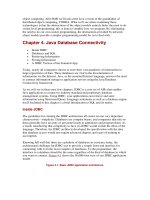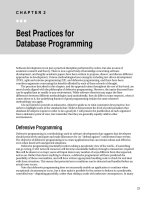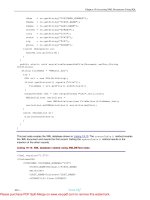Java Database Programming Bible- P11
Bạn đang xem bản rút gọn của tài liệu. Xem và tải ngay bản đầy đủ của tài liệu tại đây (800.52 KB, 50 trang )
Chapt er 19:Accessing XML Documents Using SQL
-501 -
cNum = rs.getString("CUSTOMER_NUMBER");
fName = rs.getString("FIRST_NAME");
lName = rs.getString("LAST_NAME");
street = rs.getString("STREET");
city = rs.getString("CITY");
state = rs.getString("STATE");
zip = rs.getString("ZIP");
phone = rs.getString("PHONE");
}catch (Exception e){
System.out.println(e);
}
}
public static void serializeDocumentAsFile(Document xmlDoc,String
UrlString){
String fileName = "XMLOut.xml";
try {
URL url = new URL(UrlString);
if(url.getProtocol().equals("file")){
fileName = url.getFile().substring(1);
}
OutputFormat fmt = new OutputFormat("xml",null,true);
XMLSerializer serializer =
new XMLSerializer(new FileWriter(fileName),fmt);
serializer.asDOMSerializer().serialize(xmlDoc);
}
catch (Exception e){
e.printStackTrace();
}
}
}
This test code creates the XML database shown in Listing 19-13. The createTable() method creates
the XML document and inserts the first record. Calling the updateTable() method results in the
insertion of the other records.
Listing 19-13: XML database created using XMLDBTest class
<?xml version="1.0"?>
<CustomerDB>
<CUSTOMER CUSTOMER_NUMBER="100">
<FIRST_NAME>Michael</FIRST_NAME>
<MI>A</MI>
<LAST_NAME>Corleone</LAST_NAME>
<STREET>123 Pine</STREET>
TEAMFLY
Team-Fly
®
Please purchase PDF Split-Merge on www.verypdf.com to remove this watermark.
Chapt er 19:Accessing XML Documents Using SQL
-502 -
<CITY>New York</CITY>
<STATE>NY</STATE>
<ZIP>10006</ZIP>
<PHONE>201-555-1212</PHONE>
</CUSTOMER>
<CUSTOMER CUSTOMER_NUMBER="101">
<FIRST_NAME>Vito</FIRST_NAME>
<MI>Q</MI>
<LAST_NAME>Corleone</LAST_NAME>
<STREET>137 Main</STREET>
<CITY>New York</CITY>
<STATE>NY</STATE>
<ZIP>10006</ZIP>
<PHONE>201-555-1213</PHONE>
</CUSTOMER>
<CUSTOMER CUSTOMER_NUMBER="102">
<FIRST_NAME>James</FIRST_NAME>
<MI>J</MI>
<LAST_NAME>Corleone</LAST_NAME>
<STREET>123 Pine</STREET>
<CITY>New York</CITY>
<STATE>NY</STATE>
<ZIP>10006</ZIP>
<PHONE>201-555-1214</PHONE>
</CUSTOMER>
<CUSTOMER CUSTOMER_NUMBER="103">
<FIRST_NAME>Raquel</FIRST_NAME>
<MI>S</MI>
<LAST_NAME>Corleone</LAST_NAME>
<STREET>123 Pine</STREET>
<CITY>New York</CITY>
<STATE>NY</STATE>
<ZIP>10006</ZIP>
<PHONE>201-555-1215</PHONE>
</CUSTOMER>
<CUSTOMER CUSTOMER_NUMBER="104">
<FIRST_NAME>James</FIRST_NAME>
<MI>J</MI>
<LAST_NAME>Witherspoon</LAST_NAME>
<STREET>17 Oak</STREET>
<CITY>New York</CITY>
<STATE>NY</STATE>
<ZIP>10006</ZIP>
Please purchase PDF Split-Merge on www.verypdf.com to remove this watermark.
Chapt er 19:Accessing XML Documents Using SQL
-503 -
<PHONE>201-555-1216</PHONE>
</CUSTOMER>
<CUSTOMER CUSTOMER_NUMBER="105">
<FIRST_NAME>Fred</FIRST_NAME>
<MI>Q</MI>
<LAST_NAME>Bloggs</LAST_NAME>
<STREET>22 Walnut</STREET>
<CITY>New York</CITY>
<STATE>NY</STATE>
<ZIP>10006</ZIP>
<PHONE>201-555-1217</PHONE>
</CUSTOMER>
</CustomerDB>
Note that although the SQL CREATE command specifies type VARCHAR (30) for most of the fields, this
type specification defaults to String. The reason for this is that all data is stored as a String, and the only
significance attached to data type is to check for the custom type ATTRIBUTE, which is used to denote
that the field should be added to the row element as an attribute.
Note also that the XML document must be saved after each update. The XML database actually exists
as a DOM document in memory, so it must be serialized after changes are made.
Tests are carried out using a variety of different queries. These queries include the following:
SELECT * FROM CUSTOMER
SELECT * FROM CUSTOMER WHERE FIRST_NAME LIKE 'M%'
SELECT * FROM CUSTOMER WHERE FIRST_NAME NOT LIKE 'M%'
SELECT * FROM CUSTOMER WHERE FIRST_NAME NOT = 'Michael'
SELECT * FROM CUSTOMER WHERE FIRST_NAME <> 'Michael'
SELECT * FROM CUSTOMER WHERE FIRST_NAME LIKE 'M%' OR FIRST_NAME LIKE 'F%'
SELECT * FROM CUSTOMER WHERE (FIRST_NAME LIKE 'M%' OR FIRST_NAME LIKE 'V%')
SELECT * FROM CUSTOMER WHERE ( FIRST_NAME LIKE 'M%' OR CUSTOMER_NUMBER =
'102' )
In addition to supporting the ResultSet.getString() method used to set the String variables in
Listing 19-12, the XMLResultSet can also be retrieved as an XML document. Listing 19-14 shows the
XMLResultSet generated by running this query:
SELECT * FROM CUSTOMER WHERE
( FIRST_NAME LIKE 'M%' OR CUSTOMER_NUMBER = '102' ) AND LAST_NAME =
'Corleone'
Listing 19-14: XMLResultSet
<?xml version="1.0"?>
<RESULTSET>
<CUSTOMER CUSTOMER_NUMBER="100">
<FIRST_NAME>Michael</FIRST_NAME>
<MI>A</MI>
<LAST_NAME>Corleone</LAST_NAME>
Please purchase PDF Split-Merge on www.verypdf.com to remove this watermark.
Chapt er 19:Accessing XML Documents Using SQL
-504 -
<STREET>123 Pine</STREET>
<CITY>New York</CITY>
<STATE>NY</STATE>
<ZIP>10006</ZIP>
<PHONE>201-555-1212</PHONE>
</CUSTOMER>
<CUSTOMER CUSTOMER_NUMBER="102">
<FIRST_NAME>James</FIRST_NAME>
<MI>J</MI>
<LAST_NAME>Corleone</LAST_NAME>
<STREET>123 Pine</STREET>
<CITY>New York</CITY>
<STATE>NY</STATE>
<ZIP>10006</ZIP>
<PHONE>201-555-1214</PHONE>
</CUSTOMER>
</RESULTSET>
The advantage of returning the entire XMLResultSet as an XML document is that many applications
are designed to work with XML. In this form, the XMLResultSet can be transferred between
applications or manipulated using an XSL transform.
Since the target database is defined by a URL, you are not restricted to using local XML files as
databases. Try substituting the URL />local/page?o=xml&query=top+stories.
Cross-
Reference
Chapter 17 discusses working with XML sources over the Internet.The
examples are based on accessing the Web
site.
Summary
In this chapter, you learn to create a JDBC driver and a simple SQL engine. The examples can be
expanded and modified to form the basis of any custom application requiring a JDBC API. The main
topics covered included the following:
§ Detailed operation of a JDBC driver
§ A simple, String-oriented SQL query engine
§ Examples of working with XML documents
This chapter ends Part IV. Part V explores persistence in the context of Enterprise Java Beans and JDO.
Please purchase PDF Split-Merge on www.verypdf.com to remove this watermark.
Part V:EJBS, Databases, and Persistence
-505-
Part V: EJBs, Databases, and
Persistence
Chapter List
Chapter 20: Enterprise JavaBeans
Chapter 21: Bean-Managed Persistence
Chapter 22: Container-Managed Persistence
Chapter 23: Java Data Objects and Persistence
Part Overview
Part V is a discussion of the use databases in the context of J2EE applications using Enterprise
JavaBeans. The first chapter gives a brief overview of Enterprise JavaBeans, including descriptions of:
§ The three types of Enterprise JavaBeans: session beans, entity beans, and message-driven
beans.
§ Activation and passivation
§ Bean-managed persistence and container-managed persistence
§ Enterprise JavaBean transactions
After reading this chapter, you should have a good understanding of Enterprise JavaBeans and of the
ways they interact with databases.
Subsequent chapters discuss bean-managed persistence and container-managed persistence, with
extensive examples. They include sections on the use of JDBC and SQL in bean-managed persistence
and of the Enterprise JavaBean query language (EJBQL).
The final chapter in Part V covers Java data objects and transparent persistence. This is a new
technology that handles persistence in a manner that is completely transparent to the developer.
Please purchase PDF Split-Merge on www.verypdf.com to remove this watermark.
Chapter 20:Enterprise JavaBeans
-506 -
Chapter 20: Enterprise JavaBeans
In This Chapter
This chapter gives a brief overview of Enterprise JavaBeans (EJBs). The features and purposes of three
types of EJBs are discussed. The fundamentals of transaction and persistence management are
reviewed. After reading this chapter, you should have a good understanding of Enterprise JavaBeans
(EJBs) and of the ways they interact with databases.
Enterprise JavaBeans Overview
The Enterprise JavaBeans Specification defines EJBs as follows: "Enterprise JavaBeans is an
architecture for component-based distributed computing. EJBs are components of the distributed
transaction-oriented enterprise applications." In a nutshell, EJBs are server-side components that
encapsulate the business logic of an application. The business logic is the code that fulfills the purpose
of the application. For example, in an online shopping application, the EJBs might implement the
business logic in methods called searchCatalog and checkOut. By invoking these methods, remote
clients can access the online shopping services the application provides.
An EJB typically communicates with Enterprise Information Systems (EIS) such as databases and
legacy systems and other EJBs. At the same time, different types of clients access EJBs requesting
services. The clients can be other EJBs, Web applications, servlets, or application clients.
At runtime, an EJB resides in an EJB container. An EJB container provides the deployment and runtime
environment for EJBs, including services such as security, transaction, deployment, concurrency
management, and instance life-cycle management. The process of installing an EJB in an EJB
container is called EJB deployment. EJB containers are typically part of an application server. EJBs by
nature are portable components; therefore, the application assembler can build new applications from
existing beans with minimum effort. These applications can run on any J2EE-compliant application
servers.
EJBs are designed to simplify the development of large, distributed applications. Because the EJB
container provides system-level services to enterprise beans, the bean developer can concentrate on
solving business problems. The EJB container, not the bean developer, is responsible for system-level
services such as transaction management and security authorization. Furthermore, since the
application's business logic is contained in EJBs instead of in clients, client developers can focus on the
presentation of the client. The client developer does not have to code the routines that implement
business rules or access databases. As a result, clients are thinner. This is particularly beneficial for
clients that run on small devices such as cell phones or PDAs.
EJBs are especially suitable for applications that have the following requirements and characteristics:
§ Scalablability. To accommodate a growing number of users, one may need to distribute an
application's components across multiple machines. Not only can the EJBs of an application run on
different machines, but their location remains transparent to clients.
§ Transactions-oriented. EJBs support transactions through container services, the mechanisms
that manage the concurrent access of shared objects and ensure data integrity.
§ Multiple types of clients. With just a few lines of code, remote clients can easily locate enterprise
beans. These clients can be thin, various, and numerous.
The EJB 2.0 Specification specifies the three following types of EJBs:
§ Session beans
§ Entity beans
§ Message-driven beans
The features, as well as the appropriate uses of each type of EJB, are discussed in more details in the
following sections.
Session Beans
Please purchase PDF Split-Merge on www.verypdf.com to remove this watermark.
Chapter 20:Enterprise JavaBeans
-507 -
A session bean represents a single client inside the J2EE server and performs tasks on behalf of the
client. This type of bean manages sessions (or conversations between the client and the server) on
behalf of the client. A typical session is transient, and its state is usually not persistent. An example of a
session is tracking your courier package using a Web-based status-query application. If, for some
reason, the Web server dies or the session times out, the session terminates, and the user is required
to start a new session. Most online transactions are session oriented, with the user initiating a session
performing a set of actions and then terminating a session. Hence, a session bean generally stores its
state in transient variables.
Not all sessions are conversational. Some sessions involve only one interaction between the client and
server. For example, getting a stock quote does not need the multiple invocations of the service the
stock-quote server provides. These sessions are stateless, and their management can be significantly
simplified. To address these different scenarios, the EJB specification specifies two types of session
beans: stateful and session.
In general, the use a session bean is appropriate if the following circumstances hold:
§ At any given time, only one client has access to the bean instance.
§ The state of the bean is not persistent, existing only for a short period (perhaps a few hours).
Once the session bean is chosen, we still need to decide which one to use, stateless or stateful, based
on whether a conversational state needs to be held in the session bean.
Stateless Session Beans
Stateless session beans are components that implement a single-use service. That service can be
invoked many times, but since the component does not maintain any state, the effect is that each
invocation provides a single use. In a lot of ways, stateless session beans provide a reusable single-use
service.
Although a stateless session bean does not maintain a conversational state for a particular client, it may
contain a transient state in the form of its instance variables, as shown in the code example. When a
client invokes the method of a stateless bean, the values of the bean's instance variables represent
such a transient state but only for the duration of the invocation. When the method is finished, the state
is no longer retained. Except during method invocation, all instances of a stateless bean are equivalent,
allowing the EJB container to assign an instance to any client. Most of application servers take
advantage of this feature and pool the stateless session beans to achieve better performance.
Because stateless session beans can support multiple clients and usually are pooled in the EJB
container, they can offer better scalability for applications that require large numbers of clients. Typically,
an application requires fewer stateless session beans than stateful session beans to support the same
number of clients. At times, the EJB container may write a stateful session bean to secondary storage
(called passivation, discussed later). However, stateless session beans are never written to secondary
storage. This further makes stateless beans offer better performance than stateful beans.
The major advantage of stateless session beans over stateful session beans is performance. A
stateless session bean should be chosen if one of following is true:
§ The bean's state has no data for a specific client.
§ In a single-method invocation, the bean performs a generic task for all clients. For example, you
might use a stateless session bean to retrieve stock quotes at any time.
§ The bean fetches from a database a set of read-only data that is often used by clients. Such a
bean, for example, can retrieve the table rows that represent the inventory that currently below
certain level.
In general, the steps for developing EJBs include:
1. Write the remote interface.
2. Write the home interface.
3. Write the EJB implementation class.
4. Compile the EJB and all its supporting files.
5. Write the deployment descriptors.
6. Package and deploy.
Please purchase PDF Split-Merge on www.verypdf.com to remove this watermark.
Chapter 20:Enterprise JavaBeans
-508-
Note
Many of the preceding steps can be performed automatically by a variety of IDEs. Don't
write everything from scratch.
Although your favorite IDE may complete many steps for you, let's go through these steps manually in
the development of our stateless session bean example. To keep things less confusing, a naming
convention should be adopted for all the Java classes involved. A commonly accepted naming
convention is listed in Table 20-1.
Table 20-1: EJB Name Convention
Item Name Example
Remote Interface <name> Customer
Home Interface <name>Home CustomerHome
Implementation Class <name>Bean CustomerBean
EJB Name <name>EJB CustomerEJB
EJB Jar Display Name <name>Jar CustomerJar
Remember the first program you have ever written in Java? Is it the "Hello, world"? The first EJB
example developed in this chapter is a stateless session bean called HelloEJB. When it is invoked, a
welcome message is delivered to the calling client.
Although the business logic is defined in the implementation class, the client can never directly access
implementation-class instances. Instead, the client calls an EJB's remote interface to get its service. In
other words, the remote interface defines the business methods that a remote client may invoke. The
bean developer defines the types of the method arguments, the return type, and the exceptions the
methods throw. The signatures of these methods must be identical to the signatures of the
corresponding methods in the EJB implementation class.
Remote interface
Every EJB remote interface extends the java.ejb.EJBObject interface. Since EJBs are meant to
work in a distributed system, the remote interface is a valid remote interface for RMI-IIOP, so each
method must throw the java.rmi.RemoteException. The source code for the HelloEJB remote
interface is shown in Listing 20-1. Three methods are defined by which a client can get all welcome
messages, a specific welcome message, or the number of messages.
Listing 20-1: Remote interface of HelloEJB
package java_database.ch20.HelloSLBean;
import javax.ejb.*;
import java.rmi.RemoteException;
public interface Hello extends EJBObject {
public String[] getAllWelcomeMsgs() throws RemoteException;
public String getWelcomeMsg(int i) throws RemoteException;
public int getNumberOfWelcomeMsgs() throws RemoteException;
}
Home interface
Please purchase PDF Split-Merge on www.verypdf.com to remove this watermark.
Chapter 20:Enterprise JavaBeans
-509 -
The home interface controls the life cycle of the EJB objects. For a session bean, the purpose of the
home interface is to define the create methods that a remote client may invoke to create its reference
to the EJB object. You may define multiple create methods with different signatures. The default
method without any argument is used to instantiate EJB objects in the container.
Note that create methods are different from constructors. A constructor is an initializer for an object
(which may exist for a very long time). A create method is used by clients to initialize an EJB instance
in an EJB container. An EJB instance may be composed of one object or a variety of objects over its life
cycle. As such, it has different initialization mechanisms.
Understanding the life cycle is critical in mastering EJBs. Unfortunately, that is beyond the scope of this
book. The interested reader can find extensive discussions on EJB life cycles in numerous EJB books.
Note
Do not assume that create methods are the same as constructors.
As is the case for the remote interface, the signatures of the create methods defined in the home
interface must correspond to those of its corresponding ejbCreate methods in the implementation
class. The throws clause of the create method must include java.rmi.RemoteException and
the javax.ejb.CreateException. The home interface of the HelloEJB is shown in Listing 20-2.
Only one create method is defined in this example.
Listing 20-2: Home interface of HelloEJB
package java_database.ch20.HelloSLBean;
import javax.ejb.*;
import java.rmi.RemoteException;
public interface HelloHome extends EJBHome {
public Hello create() throws CreateException, RemoteException;
}
Implementation class
Most of the work that you have to do as a bean developer occurs in the bean class itself. There are a
number of methods the bean class must provide. An important method, and perhaps the most confusing
one, is ejbCreate.
Because an enterprise bean runs inside an EJB container, a client cannot directly instantiate the bean.
Only the EJB container can instantiate an enterprise bean. During instantiation, the example program
performs the following steps:
1. The client invokes a create method on the home object
2. The EJB container instantiates the EJB instance.
3. The EJB container invokes the appropriate ejbCreate method in the implementation class;
typically, an ejbCreate method initializes the state of the EJB instance.
create and ejbCreate method guidelines
Typically, an ejbCreate method initializes the state of the EJB instance. The guidelines for writing
such methods are:
§ Each create method defined in the home interface must have a corresponding ejbCreate
method in the bean-implementation class.
§ The number of arguments and argument data types between the ejbCreate and the
corresponding create methods must be the same.
Please purchase PDF Split-Merge on www.verypdf.com to remove this watermark.
Chapter 20:Enterprise JavaBeans
-510-
§ Since the ejbCreate is called by the container, there is nothing to return so its return type is
void.
§ The create method returns the remote interface.
The bean class extends the java.ejb.SessionBean interface, which declares the ejbRemove,
ejbActivate, ejbPassivate, and setSessionContext methods. The HelloBean class does
not use these methods, but it must implement them (as empty functions). Later sections on stateful
session beans and entity beans explain the use of these methods.
EJBExceptions
The primary purpose of a session bean is to run business tasks for the client. The client invokes
business methods on the remote object reference that the create method returns. From the client's
perspective, the business methods appear to run locally, although they actually run remotely in the
application server's EJB container. All the business methods declared in the remote interface need to
be implemented. The signatures of these business methods are the same as those defined in the
remote interface. However, since the bean object is running inside of the container, it does not need to
throw the java.rmi.RemoteException.
To indicate a system-level problem, such as the inability to connect to a database, a business method
should throw javax.ejb.EJBException. When a business method throws an EJBException, the
container wraps it in a RemoteException, which is caught by the client. Since EJBException is a
subclass of RuntimeException, you do not need to explicitly include it in the throws clause of the
business method. The HelloBean class is shown in Listing 20-3. It should be noted that the method
getWelcomeMsg(int) is coded defensively to prevent the index from going out of range.
Listing 20-3: HelloBean class
package java_database.ch20.HelloSLBean;
import javax.ejb.*;
import java.util.*;
public class HelloBean implements SessionBean
{
// instance variables
private SessionContext ctx;
private String[] msgList = new String[3];
// default constructor – different from ejbCreate()
public HelloEJBBean() {
}
// Life cycle methods called by EJB container
public void setSessionContext(SessionContext c) {
System.out.println("setSessionContext called.");
ctx = c;
}
public void ejbCreate() {
System.out.println ("ejbCreate() called.");
Please purchase PDF Split-Merge on www.verypdf.com to remove this watermark.
Chapter 20:Enterprise JavaBeans
-511-
msgList[0] = "Hello!";
msgList[1] = "Welcome to the EJB world.";
msgList[2] = "Enjoy reading.";
}
public void ejbRemove() {
System.out.println ("ejbRemove called.");
}
public void ejbPassivate() {
System.out.println("ejbPassivate called.");
}
public void ejbActivate() {
System.out.println("ejbActivate() called.");
}
// Business methods serving the client's need
public String[] getAllWelcomeMsgs() {
return msgList;
}
public String getWelcomeMsg(int i) {
// first make sure index is not out of range
i = (i >= msgList.length) ? (msgList.length - 1) : i;
i = (i < 0) ? 0 : i;
// return welcome message
return msgList[i];
}
public int getNumberOfWelcomeMsgs() {
return msgList.length;
}
}
Where is the database-access code? After all, this is a book on Java database programming. Since EJB
itself is complex enough, I have deliberately kept the first EJB example as simple as possible (the spirit
of the HelloWorld example). As soon as you have this piece of code running, you can easily extend it
to fulfill your needs, such as accessing databases using the JDBC programming skills you have learned
from previous chapters. For example, the welcome messages may be stored in a database table. Then
in the ejbCreate method, you do not need to initialize the msgList array; instead, an instance of
javax.sql.DataSource should be initialized. And the business methods access the DataSource
and retrieve the welcome message (or count the number of rows) from the message table. You can find
code samples of initializing and accessing DataSource objects in next chapter.
After the bean classes are coded, they need to be packaged and deployed. Most application servers
have built-in tools for EJB (and enterprise application) deployment. The key artifacts of the deployment
process are the deployment descriptors, the XML files that contain the declarative information about the
EJBs and the enterprise application. Most of the container vendors use some proprietary technology to
enhance the performance of their product. As a consequence, the deployment descriptor usually
contains two files: one is the strictly J2EE standard, and the other is vendor specific. As an example, the
TEAMFLY
Team-Fly
®
Please purchase PDF Split-Merge on www.verypdf.com to remove this watermark.
Chapter 20:Enterprise JavaBeans
-512-
deployment-descriptor files for WebLogic application server (version 6.1) are listed in Listing 20-4. If you
use different application servers, the files may look different.
Listing 20-4: Deployment-descriptor files for HelloEJB
# First file: J2EE standard
<!DOCTYPE ejb-jar PUBLIC "-//Sun Microsystems, Inc.//DTD Enterprise
JavaBeans 2.0//EN" "
<ejb-jar>
<enterprise-beans>
<session>
<ejb-name>HelloEJB</ejb-name>
<home>HelloSLBean.HelloHome</home>
<remote>HelloSLBean.Hello</remote>
<ejb-class>HelloSLBean.HelloBean</ejb-class>
<session-type>Stateless</session-type>
<transaction-type>Container</transaction-type>
</session>
</enterprise-beans>
</ejb-jar>
#Second file: WebLogic specific
<?xml version="1.0"?>
<!DOCTYPE weblogic-ejb-jar PUBLIC '-//BEA Systems, Inc.//DTD WebLogic
6.0.0 EJB//EN' '
jar.dtd'>
<weblogic-ejb-jar>
<weblogic-enterprise-bean>
<ejb-name>HelloEJB</ejb-name>
<jndi-name>Hello</jndi-name>
</weblogic-enterprise-bean>
</weblogic-ejb-jar>
You can see that the first XML file specifies the EJB name, remote interface name, home interface
name, and bean class name. It specifies that HelloEJB is a stateless session bean, and the container
manages its database transaction (transaction management is discussed later). The second file
specifies the EJB's Java Naming and Directory Interface (JNDI) name, which the client uses to look up
the EJB.
Now that the EJB has been developed, it is time to code the client. The steps for a client to invoke EJB
services are as follows:
1. Instantiate an InitialContext instance.
2. Look up the home interface from JNDI.
3. Create a remote interface instance as the EJB reference.
4. Invoke EJB services via the reference.
These steps are illustrated in the JSP client listed in Listing 20-5. The output of the test is shown in
Figure 20-1. Bounds checking coded into the method getWelcomeMsg(int) prevent the array index
Please purchase PDF Split-Merge on www.verypdf.com to remove this watermark.
Chapter 20:Enterprise JavaBeans
-513-
from going out of range, so there is always a welcome message returned for any integers passed into
the method.
Figure 20-1: Test output after the JSP client shown in Listing 20-5
Listing 20-5: JSP client
<%@ page import="javax.naming.*, java.rmi.*,
java_database.ch20.HelloSLBean.*" %>
<%! private static Context ctx;
// Instantiate InitialContext
static {
try {
ctx = new InitialContext();
} catch (Exception e) {
System.out.println(e);
System.out.println("Error trying to do one time initialization.");
}
}
// A utility method that output a message to browser with a line
breaker <BR>
public void toBrowser(String msg, JspWriter out) throws Exception {
out.print(msg + "<BR>");
}
// Action starts
toBrowser("Beginning client.jsp", out);
// Look up home interface
HelloEJBHome home = (HelloEJBHome)ctx.lookup("Hello");
Please purchase PDF Split-Merge on www.verypdf.com to remove this watermark.
Chapter 20:Enterprise JavaBeans
-514-
// Create remote interface
HelloEJB bean = (HelloEJB)home.create();
// Invoke EJB services through remote interface reference
String[] messages= bean.getAllWelcomeMsgs();
toBrowser("<BR>Available messages:", out);
for(int i=0; i<bean.getNumberOfWelcomeMsgs(); i++) {
toBrowser(messages[i], out);
}
//Test out-of-range index
toBrowser("<BR>", out);
toBrowser("Trying message No. -1", out);
toBrowser("Message No. -1: " + bean.getWelcomeMsg(-1), out);
toBrowser("<BR>", out);
toBrowser("Trying message No. 4", out);
toBrowser("Message No. 4: " + bean.getWelcomeMsg(4), out);
}
%>
Stateful Session Bean
A stateful session bean typically implements a conversational business process. A shopping cart of an
online shopping application is a classical example of a stateful session bean. While a shopper searches
the catalog and keeps dropping items into his or her shopping cart, the item list must be maintained.
Obviously, different shoppers' shopping carts cannot be mixed. Only after a shopper finally checks out
are the purchased items transferred into a persistent data store (such as a database).
A shopping cart application differs from a catalog-search application, for example, because each time
the user searches the catalog, the search criteria are different. Such a service is usually implemented
by a stateless session bean. This means that, unlike stateless session beans, a stateful session bean
cannot serve multiple clients. An instance of a stateful session bean is associated with only one client.
The instance retains the state on behalf of the client across multiple method invocations.
There is a one-to-one correspondence between user sessions (maintained as HttpSession objects)
and the instances of a stateful session bean. The EJB container always delegates the method
invocation from a given client to the same stateful session bean instance. The instance variables of the
stateful session bean provide a convenient mechanism for the application developer to retain a client-
specific state on the server. Note that such a state is not persistent on any data store. If the session is
timed out, or if the server is crashed, the states are lost. If the states need to be persistent against
server crash, entity beans must be used.
A client initiates the life cycle of a stateful session EJB in the same way as stateless session beans: by
invoking the create method in its home interface. The EJB container instantiates the bean and then
invokes the setSessionContext and ejbCreate methods in the session bean. The bean is now
ready to have its business methods invoked.
Unlike stateless session beans, stateful session instances cannot be pooled because of the one-to-one
correspondence between bean instances and session objects. At the end of the client session (for
example, the online shopper checks out), the client invokes the remove method, and the EJB container
calls the bean's ejbRemove method. The bean's instance is then ready for garbage collection.
Please purchase PDF Split-Merge on www.verypdf.com to remove this watermark.
Chapter 20:Enterprise JavaBeans
-515-
Passivation and activation
A stateful session object lasts for the duration of the business process that typically spans multiple
client-invoked business methods. The process may last for several minutes, hours, or even days.
During its life cycle, the state of a stateful session instance may occupy a nontrivial amount of main
memory on the server. In addition, the state may include expensive resources such as database
connections. Because of these factors, it is important that the EJB container be able to reclaim the
resources (when the available resources become too low) by saving the state into some form of
secondary memory, such as a database or file systems. Later, when the state of the session object is
once again needed for the invocation of a business method, the EJB container can restore the state
from the saved image.
The process of saving the session objects' state to secondary storage is called passivation, whereas the
process of restoring the state is called activation. The container typically passivates a session object
when it needs to free resources in order to process requests from other clients or when it needs to
transfer the session bean instance to a different process for load-balancing purposes. The container
passivates the instance by invoking the ejbPassivate method and then serializing the instance and
moving it to some secondary storage. When it activates the session objects, it restores the session
bean's instance by deserializing the saved image of the passivated instance and then invoking the
ejbActivate method.
For many session beans, including the example YachtSessionEJB, the passivation and activation
processes do not require any programming effort from the bean developer. The bean developer has
only to ensure that the objects held in the session bean instance variables are serializable at
passivation. An object is serializable if it is an instance of a class that has implemented the
java.io.Serializable interface.
Business processes and rules
In this chapter and the next two, we build a simple example application to demonstrate the use of
stateful session beans and entity beans. Please note that these example EJBs are written for
educational purposes only. They may not represent the best (or even appropriate) approaches for the
hypothetical business process. The error and exception handling are not enough for these programs to
be used in any a production release. Nevertheless, once you have fully understood the example code
and have had it running, you can easily extend its functionality to meet your needs. In that sense, it
serves as a good starting point for your own EJB application development.
The example application is used for a yacht club in its yacht cruise operation. From time to time, the
club offers its members free yacht cruises. The business process includes the following tasks:
§ Operate the yacht such as start, stop, accelerate and decelerate.
§ Check the status of the yacht.
§ Pick up a club members as a passengers (only members can come on board).
§ Drop off passengers.
Since the business process involves multiple business-method invocations, it is implemented as a
stateful session bean: YachtSessionEJB. The yacht and club members are business entities and can
be modeled by entity beans. Although the MemberEJB and the YachtEJB are developed in the next
two chapters, the YachtSessionEJB code is listed in Listings 20-6 and 20-7.
Listing 20-6: Remote and Home interfaces of YachtSessionEJB
/** YachtSessionEJB YachtSessionEJB
* @author: Andrew Yang
* @version: 1.0
*/
package java_database.YachtSessionSFBean;
Please purchase PDF Split-Merge on www.verypdf.com to remove this watermark.
Chapter 20:Enterprise JavaBeans
-516-
import javax.ejb.*;
import java.rmi.*;
import java_database.common.*;
import java_database.MemberEBean.*;
public interface YachtSession extends EJBObject {
public void start() throws RemoteException, YachtException;
public void stop() throws RemoteException, YachtException;
public int accelerate(int amount) throws RemoteException, YachtException;
public int decelerate(int amount) throws RemoteException, YachtException;
public void addPassenger(Member member) throws RemoteException,
YachtException;
public boolean removePassenger(Member member) throws RemoteException;
public YachtStatus getCurrentStatus() throws RemoteException;
}
/** YachtSessionEJB Home Interface
* @author: Andrew Yang
* @version: 1.0
*/
package java_database.YachtSessionSFBean;
import javax.ejb.*;
import java.rmi.*;
import java_database.YachtEBean.*;
public interface YachtSessionHome extends EJBHome {
public YachtSession create(Yacht yacht) throws CreateException,
RemoteException;
}
Listing 20-7: YachtSessionEJB implementation class
/** YachtSessionEJB Implementation Class
* @author: Andrew Yang
* @version: 1.0
*/
package java_database.YachtSessionSFBean;
import javax.ejb.*;
import java.rmi.*;
import java.util.*;
import javax.naming.*;
import java_database.common.*;
Please purchase PDF Split-Merge on www.verypdf.com to remove this watermark.
Chapter 20:Enterprise JavaBeans
-517-
import java_database.YachtEBean.*;
import java_database.MemberEBean.*;
public class YachtSessionBean implements SessionBean, SessionSynchronization
{
private int currentVelocity;
private boolean yachtRunning;
private Vector passengers;
private Yacht yacht; // Remote reference to the Yacht
private InitialContext ctx;
private SessionContext context;
public YachtSessionBean() {
try {
ctx = new InitialContext();
} catch (Exception e) {
System.out.println("Could not obtain InitialContext");
}
}
public void ejbCreate(Yacht Yacht) throws RemoteException {
yachtRunning = false;
currentVelocity = 0;
passengers = new Vector(10);
this.yacht = yacht;
}
public void setSessionContext(SessionContext c) { this.context = c; }
public void ejbRemove() { }
public void ejbActivate() { }
public void ejbPassivate() { }
public void afterBegin() { }
public void beforeCompletion() { }
public void afterCompletion(boolean committed) { }
// business methods
public void start() throws YachtException {
if((passengers == null) || (passengers.size() == 0)) {
throw new YachtException("Cannot start! No passengers in the
Yacht.");
}
yachtRunning = true;
}
Please purchase PDF Split-Merge on www.verypdf.com to remove this watermark.
Chapter 20:Enterprise JavaBeans
-518-
public void stop() throws YachtException {
if(currentVelocity > 2) {
throw new YachtException("Too fast to stop. Decelerate first!");
}
yachtRunning = false;
}
public int accelerate(int amount) throws RemoteException{
if(yachtRunning) {
currentVelocity = (currentVelocity + amount <
yacht.getMaxVelocity()) ?
(currentVelocity + amount) :
yacht.getMaxVelocity();
}
return currentVelocity;
}
public int decelerate(int amount) {
if(yachtRunning) {
currentVelocity = (currentVelocity - amount > 0) ?
(currentVelocity – amount) : 0;
}
return currentVelocity;
}
public void addPassenger(Member member) throws RemoteException,
YachtException {
if(passengers.size() == yacht.getCapacity()) {
throw new YachtException("Yacht is full (" + Yacht.getCapacity() +
")");
}
passengers.addElement(member);
}
public boolean removePassenger(Member member) {
return passengers.remove(member);
}
public YachtStatus getCurrentStatus() throws RemoteException {
YachtStatus status = new YachtStatus();
status.setCurrentVelocity(currentVelocity);
status.setYachtRunning(yachtRunning);
status.setMaxVelocity(yacht.getMaxVelocity());
Please purchase PDF Split-Merge on www.verypdf.com to remove this watermark.
Chapter 20:Enterprise JavaBeans
-519-
status.setMake(yacht.getMake());
status.setModel(yacht.getModel());
status.setCapacity(yacht.getCapacity());
// Update the passenger list
Passenger[] list = new Passenger[passengers.size()];
int counter = 0;
Enumeration enum = passengers.elements();
while (enum.hasMoreElements()) {
list[counter++] = (Member)enum.nextElement();
}
status.setPassengers(list);
return status;
}
}
You can see that a YachtSessionEJB instance is associated with a specific yacht, which is
represented by an entity-bean instance. The business rules encapsulated by this entity bean include the
following:
§ If there are any passengers on board, the yacht can be started.
§ If the speed has dropped to below a threshold (for example, 2 miles/hour), the yacht can be
stopped.
§ The yacht can be accelerated or decelerated between zero and maximum speed.
§ The status of the yacht can be checked by calling the getCurrentStatus method.
§ The session bean maintains a passenger list.
§ Only club members can board the yacht.
§ Whenever a new passenger is picked up, or a passenger leaves board, the passenger list is
updated.
The YachtSessionEJB uses other helper or utility classes such as YachtStatus, YachtException,
and so on. YachtException is the application exception that wraps the exceptions related to business
rules. Do not be distracted by these utility classes at this time. They are discussed in subsequent
chapters when we build the other parts of the example. Although the cruise process is implemented as
a session bean, the business entities such as Yacht and Club Member would be better implemented as
entity beans, as discussed next.
Entity Beans
An entity bean represents a business-entity object that exists in persistent storage mechanisms such as
relational databases, object stores, or file systems. In practice, the persistent storage mechanism is
usually a relational database. Typically, each entity bean has an underlying table in a relational
database, and each instance of the bean corresponds to a row in that table. In a more complex situation,
an entity bean may represent several related database tables, and each instance may correspond to a
record in the table join. Some examples of business objects are customers, purchase orders, and
products.
The syntax of the session bean and entity bean client-view API is almost identical. However, the two
types of EJBs have different life cycles, different persistent management, and provide different
programming styles to their clients.
Entity beans are normally used under the following conditions:
§ The bean represents a business entity, not a procedure. For example, MemberEJB is be an entity
bean, but MemberRegistrationEJB is likely a session bean.
§ The state of the bean is required to be persistent. If the bean instance terminates or if the server is
shut down, the bean's state still exists in persistent storage (for example, a database).
Please purchase PDF Split-Merge on www.verypdf.com to remove this watermark.
Chapter 20:Enterprise JavaBeans
-520-
§ The bean is shared (that is, accessed simultaneously) by multiple clients.
Primary keys
Similar to a row stored in a database table, each entity bean has a unique object identifier called a
primary key. A customer entity bean, for example, might be identified by a customer number. Note that
the primary key of an entity bean is an object. In most cases, it may be simply a String object,
although it can be more complex. If the number (or integer) is used in the underlying database table, the
Java wrapper classes (such as java.lang.Integer or java.lang.Long) need to be used for the
primary key class. The primary key object enables the client to locate a particular entity-bean instance.
Persistent Storage
When an entity bean is created, the data that the EJB represents is placed into the persistent storage,
typically through a database insert operation, and a copy of that data is stored in the memory as part of
the EJB instance. Whenever the attributes of the in-memory EJB instance are modified, their underlying
persistent counterparts are automatically updated by the EJB container.
Since an entity bean's value is stored in a persistent manner, multiple clients can access the same data
at the same time. In others words, entity beans allow shared access just as a relational database allows
multiple users to access its data simultaneously. EJB containers can implement two or more clients
requesting accesses to the same data in a variety of ways. Because these clients might want to change
the same data, it's important that entity beans work within transactions. Typically, the EJB container
provides transaction management. In this case, bean developers or application assemblers specify the
transaction attributes in the bean's deployment descriptor. A bean developer does not have to code the
transaction boundaries in the bean — the container marks the boundaries based on the transaction
attributes specified in the deployment descriptor. Transaction attributes are discussed later in this
chapter.
Because the state of an entity bean is saved in a persistent storage, it exists beyond the lifetime of the
application or the server process. For example, data stored in a database still exists even after you shut
down the database server or the applications it serves.
Bean-managed persistence
There are two types of persistence for entity beans: bean managed and container managed. With bean-
managed persistence (BMP), the EJB itself is responsible for writing all of the logic necessary for
synchronizing the data between itself and the persistent store. The entity bean code that a bean
developer writes contains all the calls that access the database. A BMP bean must manage the four
following operations:
§ Add an entry to the persistent store.
§ Remove an entry from persistent store.
§ Update the persistent store with the current attribute values of the entity bean instance.
§ Update the attributes of bean instance with values stored in persistent store.
Effectively, a bean developer is responsible for coding all of the database queries. However, the
container still controls the life cycle of the bean itself.
Cross-
Reference
BMP entity beans are discussed in more detail in Chapter 21.
Container-managed persistence
Container-managed persistence (CMP) means that the EJB container handles all database access
required by the entity bean. The bean's code contains no database access (SQL) calls. As a result, the
bean's code is not tied to a specific persistent storage mechanism (database). Because of this flexibility,
even if you redeploy the same entity bean on different J2EE-compliant application servers that use
different databases, you will not need to modify or recompile the bean's code. In short, CMP entity
beans are more portable. To generate the data-access calls, the container needs information that a
bean developer provides in the entity bean's deployment descriptor.
Please purchase PDF Split-Merge on www.verypdf.com to remove this watermark.









